Traditional Chinese 雜碎 Hanyu Pinyin Hanyu Pinyin | Simplified Chinese 杂碎 Cantonese Yale jaahp seui | |
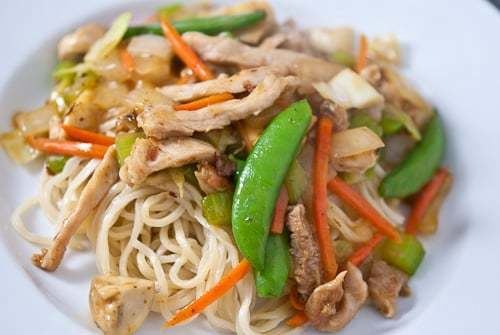 | ||
Literal meaning odds and endsassorted pieces Similar | ||
Chopsuey chop suey
Chop suey (/ˈtʃɒpˈsuːi/) is a dish in American Chinese cuisine and other forms of overseas Chinese cuisine, consisting of meat (often chicken, fish, beef, prawns, or pork) and eggs, cooked quickly with vegetables such as bean sprouts, cabbage, and celery and bound in a starch-thickened sauce. It is typically served with rice but can become the Chinese-American form of chow mein with the addition of stir-fried noodles.
Contents
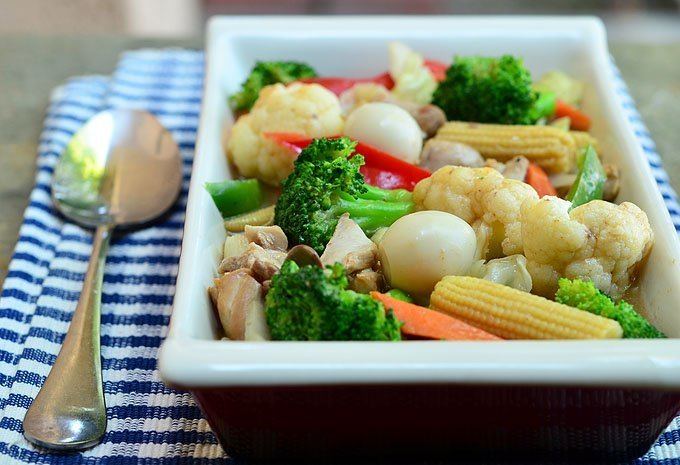
Chop suey has become a prominent part of American Chinese cuisine, Filipino cuisine, Canadian Chinese cuisine, German Chinese cuisine, Indian Chinese cuisine, and Polynesian cuisine. In Chinese Indonesian cuisine it is known as cap cai (雜菜, "mixed vegetables") and mainly consists of vegetables.
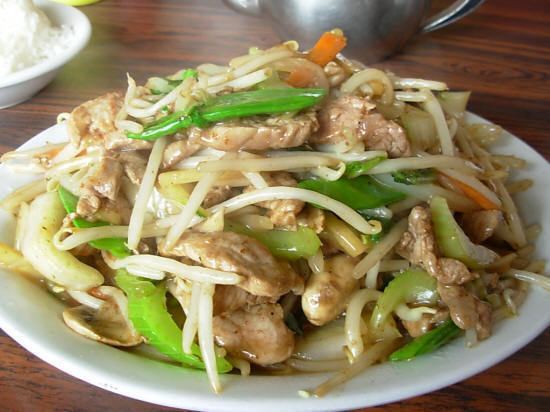
Chicken vegetable chop suey
Origins
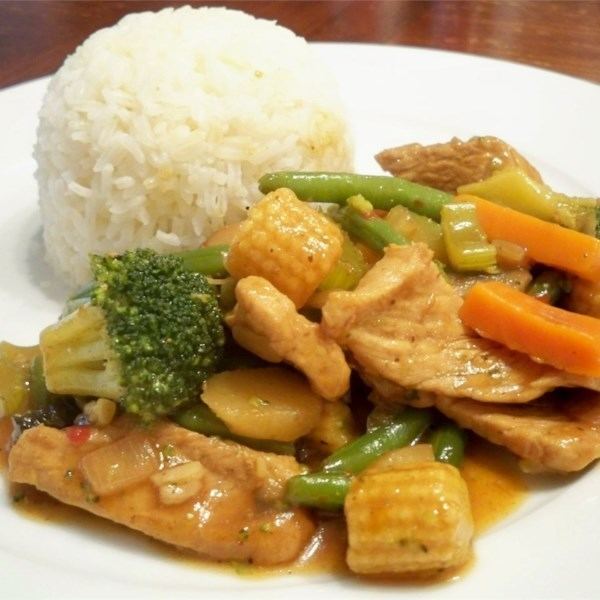
Chop suey is widely believed to have been invented in America by Chinese Americans, but the anthropologist E. N. Anderson concludes that the dish is based on tsap seui (杂碎, “miscellaneous leftovers”), common in Taishan (Toisan), a county in Guangdong province, the home of many early Chinese immigrants to the U.S. This "became the infamous 'chop suey' of third-string Chinese restaurants in the western world, but it began life as a good if humble dish among the specialist vegetable farmers of the area. At the end of the day, they would stir-fry the small shoots, thinnings, and unsold vegetables—up to ten species in a dish!" The Hong Kong doctor Li Shu-fan likewise reported that he knew it in Toisan in the 1890s.
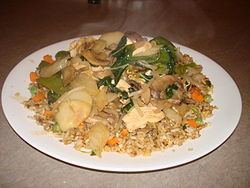
The long list of colorful and conflicting stories about the origin of chop suey is, in the words of the food historian Alan Davidson, "a prime example of culinary mythology" and typical of popular foods.
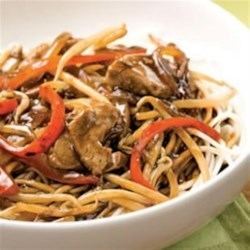
One account claims that it was invented by Chinese American cooks working on the transcontinental railroad in the 19th century. Another tale is that it was created during Qing Dynasty premier Li Hongzhang's visit to the United States in 1896 by his chef, who tried to create a meal suitable for both Chinese and American palates. Another story is that Li wandered to a local Chinese restaurant after the hotel kitchen had closed, where the chef, embarrassed that he had nothing ready to offer, came up with the new dish using scraps of leftovers. Yet recent research by the scholar Renqui Yu led him to conclude that "no evidence can be found in available historical records to support the story that Li Hung Chang ate chop suey in the United States." Li brought three Chinese chefs with him, and would not have needed to eat in local restaurants or invent new dishes in any case. Yu speculates that shrewd Chinese American restaurant owners took advantage of the publicity surrounding his visit to promote chop suey as Li's favorite.
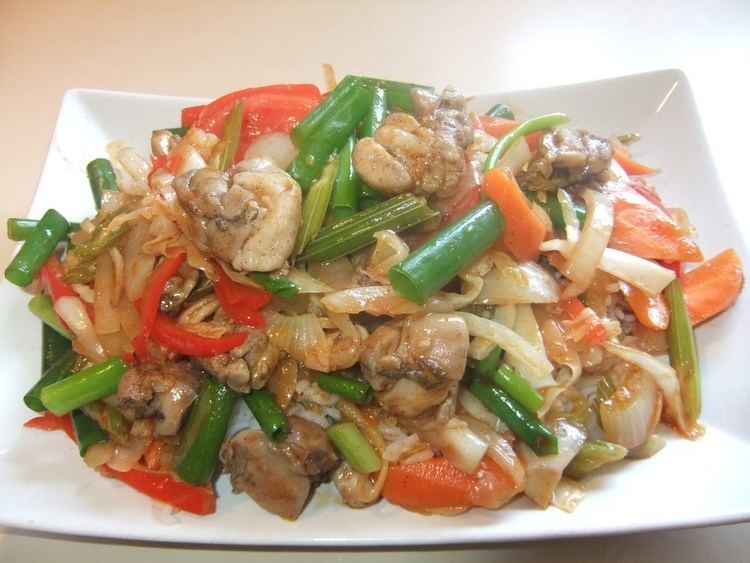
Another myth is that, in the 1860s, a Chinese restaurant cook in San Francisco was forced to serve something to drunken miners after hours, when he had no fresh food. To avoid a beating, the cook threw leftovers in a wok and served the miners who loved it and asked what dish is this—he replied chopped sui. There is no good evidence for any of these stories.
Chop suey appears in an 1884 article in the Brooklyn Eagle, by Wong Chin Foo, "Chinese Cooking", which he says "may justly be so-called the 'national dish of China'." An 1888 description states "A staple dish for the Chinese gourmand is chow chop svey [sic], a mixture of chickens' livers and gizzards, fungi, bamboo buds, pigs' tripe, and bean sprouts stewed with spices." In 1898, it is described as "A Hash of Pork, with Celery, Onions, Bean Sprouts, etc."
During his travels in the United States, Liang Qichao, a Guangdong (Canton) native, wrote in 1903 that there existed in the United States a food item called chop suey which was popularly served by Chinese restaurateurs, but which local Chinese people do not eat, because the cooking technique is really awful.
In earlier periods of Chinese history, "chop suey" or "shap sui" in Cantonese, and "za sui", in Mandarin, has the different meaning of cooked animal offal or entrails. For example, in the classic novel Journey to the West (circa 1590), Sun Wukong tells a lion-monster in chapter 75: "When I passed through Guangzhou, I bought a pot for cooking za sui – so I'll savour your liver, entrails, and lungs." This may be the same as the "Chop Suey Kiang" found in 1898 New York. The term "za sui" (杂碎) is found in newer Chinese-English dictionaries with both meanings listed: cooked entrails, and chop suey in the Western sense.
Variations
In Filipino cuisine, chop suey is composed of mixed vegetables like cauliflower, chayote, bell peppers and snow peas; and meat like pork, chicken, beef, chicken or pork liver, and cuttlefish balls.
In popular culture
The idea of chop suey was featured as a theme in the musical Flower Drum Song.
In the comic strip Pogo, Albert the alligator has a recurring song that begins with "I was eatin' some chop suey / With a lady in St. Louie."
In 2001, Armenian-American nu-metal group System Of A Down made the song, "Chop Suey."
